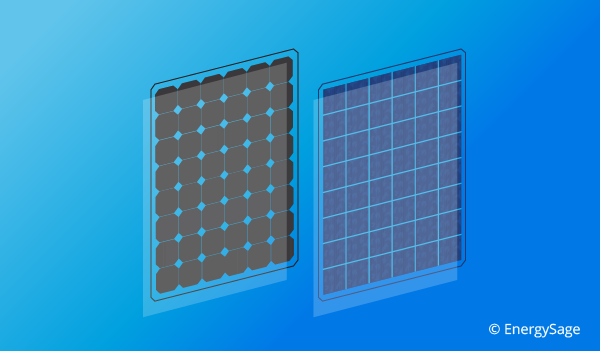When searching for the best solar panels for your home, there are many factors to consider including size, weight, and efficiency. As the solar industry continues to grow, so too do the product offerings – there are a variety of different types of solar panels available on the market today, some of which have unique advantages over traditional solar panels. One alternative to conventional panels are amorphous solar panels: thin-film solar panels that are constructed to be bendable while also using less material. In this article, we’ll explain what you need to know about this exciting technology.
Continue readingTag Archives: thin film solar

Monocrystalline and polycrystalline solar panels: what you need to know
When you evaluate solar panels for your photovoltaic (PV) system, you will encounter two main categories of panel options: monocrystalline solar panels (mono) and polycrystalline solar panels (poly). Both types of panels produce energy from the sun, but there are some key differences to be aware of.
Continue readingAre flexible solar panels right for you in 2022?
Solar panel technology is rapidly advancing every year, and new developments like flexible solar panels are constantly being released and improved upon. Compared to traditional solar panels, these panels can have a lightweight design, are able to be used for applications like charging devices and can be used independent of the electric grid. Read on to learn what flexible solar panels are, as well as how they compare to standard photovoltaic cells.
Continue readingMiaSolé thin film flexible solar panels: a silicon PV alternative for your roof
Most of the solar panels that are installed in the United States are made of silicon photovoltaic (PV) cells, but silicon PV doesn’t work for every situation. Thin film solar panels are an alternative that’s starting to take hold, particularly in situations where rigid PV panels aren’t an option.
Continue readingTypes of solar panels
Most of the solar panel options currently available fit in one of three types: monocrystalline, polycrystalline (also known as multi-crystalline), and thin-film. These solar panels vary in how they’re made, appearance, performance, costs, and the installations each are best suited for. Depending on the type of installation you’re considering, one option may be more suitable than the others.
Continue readingTypes of thin-film solar panels
Have you ever come across “flexible solar panels,” or “stick-on solar panels”? Both fit under the wider umbrella of thin-film solar panels, which is a type of solar panel technology known for being lightweight. Compared to traditional solar panel cells, thin-film solar panels are made up of electricity-producing layers that are hundreds of times thinner than typical silicon cells.
Continue readingPerovskite solar cells: the future of solar?
In the continuing quest for the most efficient solar panels, a new technology has emerged as the potential future of photovoltaic technology: perovskite solar cells.
Continue readingThin film solar panels: do they make sense for residential?
In a world where new solar panels and breakthroughs in solar technology are emerging almost every month, homeowners have a lot of panel options to choose from in 2019. Among the many innovations in the panel manufacturing space, none may be more appealing and visually exciting than thin-film solar panels. In this article we’ll dig into what makes thin-film stand out from standard silicon photovoltaic (PV) panels and offer some insight on when thin-film solar is an ideal option for homeowners and the residential market.
Continue reading




